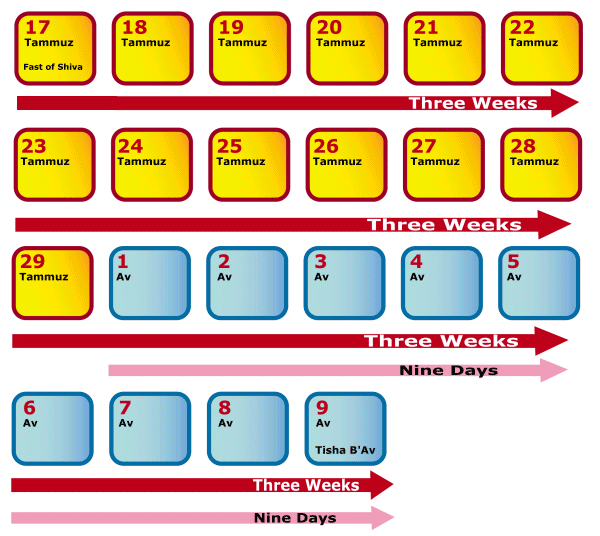The Fast of the 17th of Tammuz (Tzom Tammuz) is observed from the break of dawn until sunset. This is a more relaxed fast than Yom Kippur and Tisha B’Av as we are allowed to wash and wear leather.
Special prayers are added to the morning and afternoon services during the fast. This day is the beginning of the Three Weeks, an annual period of mourning over the destruction of the first and second Temples in Jerusalem.
Customs in Brief
- The fast of 17th Tammuz is observed only from the break of dawn.
- The sick and expectant or nursing women can observe the fast with lenience.
- One who is ill need not fast at all.
- Those permitted to eat should still refrain from eating meat, luxurious food and drink.
- Giving to charity

Reasons why we fast on this day
- Moses descended Mount Sinai on this day and, upon seeing the Golden Calf broke the first set of Tablets carrying the Ten Commandments (Shemot 32:19).
- The priests in the First Temple stopped offering the daily sacrifice on this day (Taanit 28b) due to the shortage of sheep during the siege and the next year 3184 (586 BCE), the walls of Jerusalem were breached after many months of siege by Nebuchadnezzar and his Babylonian forces.
- King Menashe, one of the worst of the Jewish kings, had an idol placed in the Holy Sanctuary of the Temple, according to tradition on this date (Melachim II 21:7). The Talmud, in Masechet Taanit 28b, says that in the time of the Roman persecution, Apostomos, captain of the occupation forces, did the same, and publicly burned the Torah. Titus and Rome breaching the walls of Jerusalem in 3760 (70 CE) and Pope Gregory IX ordering the confiscation of all manuscripts of the Talmud in 4999 (1239 CE).
- In 1391, more than 4,000 Jews were killed in Toledo and Jaen, Spain and in 4319 (1559 CE) the Jewish Quarter of Prague was burned and looted.
- The Kovno ghetto was liquidated on this day in 5704 (1944 CE)
- In 5730 (1970 CE) Libya ordered the confiscation of Jewish property.

